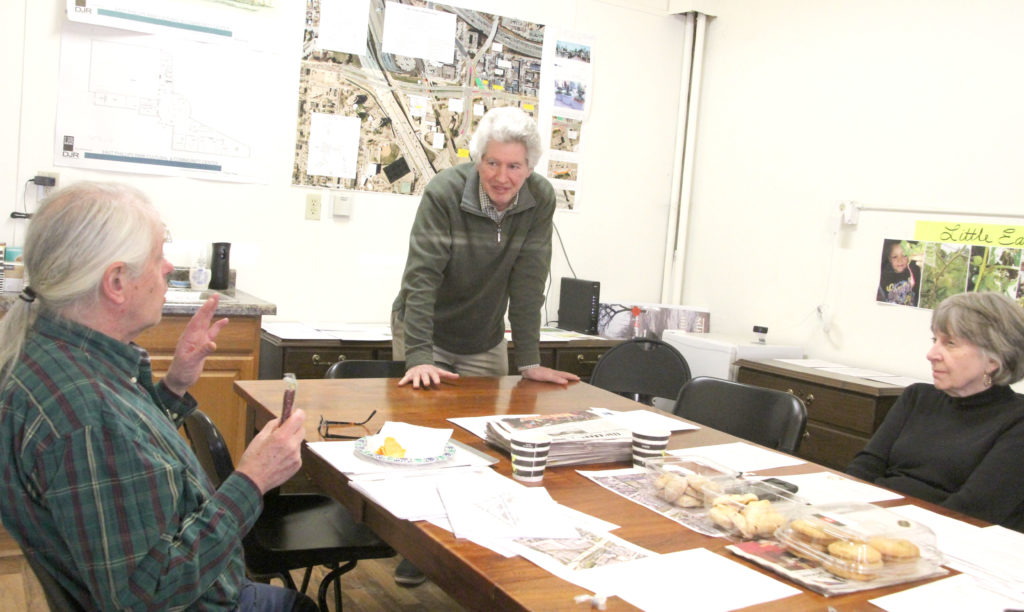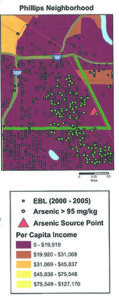Indoor urban farm supporters question why city is ignoring engaged community members who don’t want public works at Roof Depot

TESHA M. CHRISTENSEN
East Phillips Neighborhood Institute (EPNI) members (left to right) Steve Sandberg, Dean Dovolis and Karen Clark discuss the way their proposed indoor urban farm site will benefit local residents.
East Phillips Neighborhood Institute (EPNI) members (left to right) Steve Sandberg, Dean Dovolis and Karen Clark discuss the way their proposed indoor urban farm site will benefit local residents.
by Tesha M. Christensen
You don’t get a second chance after a building is torn down, and that’s why the East Phillips Neighborhood Institute (EPNI) says it is working so hard to save the 230,000-square-foot Roof Depot structure from the wrecking ball.
Architect Dean Dovolis doesn’t want to look back and say, “It could have been a community development.”
Instead, he firmly believes, “This is the right place to provide a future for the community.”
Dovolis designed the first rendition of the East Phillips Indoor Urban Farm (EPIUF) in 2014 that would have used all 7.5 acres at the Roof Depot site (1860 E 28th St.).
And then he designed the 3-acre proposal, the 2-acre proposal and the 1-acre proposal as supporters sought a compromise with the city who purchased the property out from under them in 2016 after threatening to acquire it through eminent domain if necessary.
Dovolis has been working in the Phillips neighborhood since starting DJR Architecture in 1985, and has designed multiple affordable housing and other projects, including the Phillips Aquatic Center, and East Phillips Park Cultural and Community Center.
This indoor urban farm is yet another community-driven venture that would address racial disparity, provide economic development and fit within the city’s own plan for development along the Hiawatha lightrail line and Midtown Greenway, Dovolis pointed out. Little Earth Resident Association (LERA) is partnering in project, which would offer job training and employment to local residents, as well as a local food source. Other supporters in this diverse neighborhood include Tamales y Bicicletas, a grass-roots Latino-led neighborhood organization; South East Homes, the first East African specialized chemical health treatment program in North America; the Sierra Club, the Green Team, Women’s Environmental Institute, East Phillips Improvement Coalition (EPIC), and Seward Co-Op.
The neighborhood vision for the site includes the renewal of the Roof Depot building into an agribusiness powered by an immense solar array on the roof. The year-round, indoor urban agricultural space would be based on a collaborative farming model and support small, culturally specific businesses owned by local entrepreneurs.
Growing food locally in a manner similar to that of Holland would cut down on what’s being shipped to Minnesota from California, and keep that money in the local community, pointed out Dovolis. If you introduce fresh fruits and vegetables into people’s diets, the number of disease and health issues go down significantly. This benefits society as a whole.
The indoor urban farm would offer jobs that local residents can fill, thereby cutting down on traffic while offering employment within the neighborhood. A bike shop could be situated right on the Greenway. The site would also provide very affordable mixed-use housing.
This would completely alter the area currently known by residents as “the intersection of death” for its toxic fumes and high rate of traffic accidents.
“You have a wide range of young entrepreneurs that want to be a part of this and create a future,” stated Dovolis. “It’s very hard to make that figure through a water works job. For that reason, we can’t give up.”
PLACE TO PUT HYDRANTS OR OFFER AFFORDABLE HOUSING AND FOOD?
 “The city says we want a place to put our snow, sand, hydrants, manhole covers and records. They just want a storage place,” stated Karen Clark, who recently retired as the neighborhood’s state representative. She’s lived in the area for 40 years. “How can you turn down this gift of incredible community involvement?”
“The city says we want a place to put our snow, sand, hydrants, manhole covers and records. They just want a storage place,” stated Karen Clark, who recently retired as the neighborhood’s state representative. She’s lived in the area for 40 years. “How can you turn down this gift of incredible community involvement?”
The city’s water maintenance facility, known as the East Water Yard, is currently located on 2.4 acres in Ward 3 at Hennepin Ave. E. and 5th Ave. N. It dates back 120 years and is the hub for maintaining the city’s 1,000 miles of water mains, 16,000 valves, and manholes covers, and 8,000 hydrants.
Replacing the maintenance yard is the last major unfinished piece of a 25-year-old master plan for updating the city’s Department of Public Works facilities – but the East Phillips neighborhood group wasn’t informed about this until after it had fashioned an innovative plan for the Roof Depot site and started asking city officials for support, pointed out EPNI supporters. They were shocked to learn the plan was made without consulting local residents, and they scoff at the request now to help pick out plants for the site as being true community engagement.
The Water Distribution’s 100 maintenance staff at the East Phillips location (corner of Hiawatha and 26th St.) perform valve operations, greasing and packing of hydrants, street manhole repairs, main water repairs, and leak detection. The city expects 68 heavy equipment vehicles to go in and out several times each day from the Roof Depot site.
Steve Sandberg has been told by city representatives that they will gain efficiencies by locating public works operations at one site. “You don’t gain anything by consolidating fire hydrants and manhole covers in a sand lot,” he remarked.
Brad Pass also questions whether this is a big need. “I’ve lived in this neighborhood for 50 years and I’ve never seen them replace a fire hydrant,” he observed.
Pass mentioned that he and supporters of the urban farm project are accused of being against clean water. “That’s absurd. We absolutely favor clean water,” he said. “We would also like to breath clean air, which will be further compromised by the additional diesel trucks and commuting workers at an industrial storage facility in our residential neighborhood.”
He continued, “There will be no water treated at the Hiawatha site and the city should be able to find a nonresidential site to store their sewer pipes, sand-salt mix and manhole covers, or at least allocate 19% of their 16+ acres at the Hiawatha site to something positive and good for this traumatized community.”
POLLUTION AGAINST LAW
These city-operated diesel trucks concern neighborhood residents, who have already been fighting the traffic and pollution for years at the Bituminous Roadways asphalt plant and Smith foundry across 26th St. from the Roof Depot.
This low-income neighborhood has one of the highest levels of asthma and arsenic poisoning in children in the state. For every 10,000 people, over 200 are hospitalized because of asthma. Of the 7,000 children who live in Phillips, about 40% live in poverty and 80% fall into various ethnic groups, pointed out Clark.
That amount of pollution is not allowable in the area, according to Clark, who co-wrote the Clark/Berglin Environmental Justice Law that was enacted by the state legislature in 2008. It requires that any project in this neighborhood be reviewed by the Minnesota Pollution Control Agency to analyze the cumulative pollution effects — not only what will be caused by the new or expanded project.
Over the years, the law has been applied to projects by the Metropolitan Council, city of Minneapolis, and Abbott Northwestern Hospital, among others.
During a city GAC (Guidance Advisory Committee) meeting last fall, Clark stood up to explain this bill as it relates to the city public works project, and recalls being yelled at by Minneapolis Director of Facilities Design and Construction Bob Friddle, a tall man who rushed at her diminutive figure waving his arms. She walked out of the meeting, along with the rest of the community contingent, in protest after being told she couldn’t speak, said Clark. “It was pretty unacceptable.”
WHY ARE STAFF RUNNING CITY INSTEAD OF ELECTED OFFICIALS?
Indoor urban farm supporters want the city to respond to the big questions they’re posing.
The city has a policy encouraging community participation. Why aren’t they supporting this community-birthed project? Why haven’t they paid attention to the 400 people who signed a petition in support of the community’s plan or the many people who packed community meetings to support the indoor urban farm? Why haven’t they allowed EPNI to present before the entire city council?
The neighborhood group, in the interest of meeting community needs and those of Public Works, has offered smaller, revised plans, but they don’t see the city doing the same. “There was a lot of compromising on the part of the community,” observed Clark.
Indoor urban farm supporters also want to know why the staff directive written by neighborhood Ward 9 City Council Member Alondra Cano and approved by the entire city council in December 2018 is being ignored and misinterpreted by city staff.
Just who is driving the decisions made at city hall? Members of EPNI don’t think it is the community or even city council members.
“We’ve started to evolve into a staff-driven city,” stated Dovolis, but that’s not what he wants to see happen. “You can’t let the staff run the political process.”
THEY’RE NOT GIVING UP
In East Phillips, members of EPIC, the community, and EPNI remain determined to fight this level of pollution. After all, they’ve been at this for years.
They staved off the Hennepin County Garbage Transfer Station at Cedar and 28th in the mid 1990s; kept out the Midtown Eco-burner (Cogenerating Plant) in 2007; and convinced Xcel Energy to bury high voltage power lines along the Midtown Greenway in 2009.
In 2010, they celebrated the grand opening of the East Phillips Park Cultural & Community Center which they fought for, funded and designed; and in 2018, after a six-year battle, they came together with other Phillips organizations to save the existing swimming pool and build another in the new Phillips Aquatic Center.
They say they’re not giving up on the Roof Depot site. The stakes are too high.
“You have one chance to make this work,” stated Dovolis. “When this [building and 7.5-acres at the Roof Depot site] is gone, there will never again be this kind of aggregate land to make this work.”
This article appeared in the April edition of The Alley newspaper.

